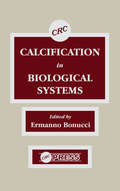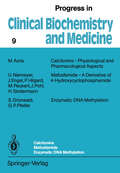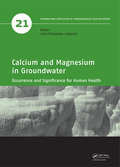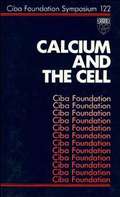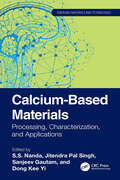- Table View
- List View
Caesium: Lieferung 1. Vorkommen, Darstellung und Eigenschaften des Metalls (Gmelin Handbook of Inorganic and Organometallic Chemistry - 8th edition #C-s / 1)
by H. J. KandinerCage Metal Complexes: Clathrochelates Revisited
by Yan Voloshin Irina Belaya Roland KrämerThis fundamental book presents the most comprehensive summary of the current state in chemistry of cage metal complexes. After their previous book “The Encapsulation Phenomenon” (www.springer.com/978-3-319-27737-0) the authors in this book focus on the encapsulation of metal ions by different types of three-dimensional mono- and polynucleating caging ligands. Within these cage metal complexes, (metal) ions can be isolated from external factors. The book provides both a classification of the cage compounds and summaries of synthetic approaches. On that basis the authors then describe the unique chemical and physical properties and the resulting reactivity of the cage compounds, as well as practical and potential applications as potent topological drugs and prodrugs, antifibrillogenic agents, radiodiagnostic and radiotherapeutic compounds, paramagnetic probes, single-molecule magnets, electrocatalysts for hydrogen production, (photo)electronic devices, and many more. Readers will find a well-structured and concise overview, with particular emphasis on a review of synthesis and reactivity of various cage metal complexes, summarizing over 400 literature references, clearly presented in over 300 color schemes and figures.
The Calabar Bean and its Alkaloids: From Magic, via Miracle, to Memory
by Brian RobinsonInvestigations into Calabar beans (the dried ripe seeds of Physostigma venenosum) and their alkaloidal components compose a classical scientific journey throughout some one-and-a-half centuries and not only represent a fascinating aspect of the history of medicine but which is, moreover, still ongoing at the forefront of chemical and medical discovery. Those in particular involving its major such component, l-physostigmine, have led to an understanding of some of the fundamental mechanisms occurring in physiology, pharmacology and biochemistry and, either actually or potentially (by providing a template and thereby acting as a “lead compound”) have provided a useful treatment for a variety of neurological disorders associated with irregularities in cholinergic transmission in which augmentation of cholinergic activity has proved to be beneficial.
Calcification in Biological Systems
by Ermanno BonucciCalcification in Biological Systems provides a collection of up-to-date papers regarding calcification in a variety of biological systems. The papers are not simple reviews of the literature. Each paper reflects the personal experience of the author(s) and is rich in constructive criticism and suggestions. Topics range from basic molecular processes to general structural problems in systems as different as unicellular organisms and human skeletal tissues. Because calcification is so diffuse in the animal kingdom, this book makes no attempt to achieve a conclusive synthesis of available results and current ideas. Instead, its merit lies in its ability to be useful to investigators with different scientific backgrounds and areas of interest.
Calcification in Biological Systems
by Ermanno BonucciCalcification in Biological Systems provides a collection of up-to-date papers regarding calcification in a variety of biological systems. The papers are not simple reviews of the literature. Each paper reflects the personal experience of the author(s) and is rich in constructive criticism and suggestions. Topics range from basic molecular processes to general structural problems in systems as different as unicellular organisms and human skeletal tissues. Because calcification is so diffuse in the animal kingdom, this book makes no attempt to achieve a conclusive synthesis of available results and current ideas. Instead, its merit lies in its ability to be useful to investigators with different scientific backgrounds and areas of interest.
Calcified Tissue (Topics in Molecular and Structural Biology)
Understanding the relationship between the structures and functions of calcified tissues is essential for an understanding of their pathology. This book emphasises aspects of calcification which are important to humans and presents aspects of current research, notably attempts to relate biological function to the structures and interactions, many chapters stress the importance of the extracellular matrix, and provide links with volumes 5 and 13 in the series Connective Tissue Matrix and Connective Tissue Matrix Part II respectively. Material selected for inclusion in this volume intentionally favour the more physical and physico-chemical aspects of contemporary research.
Calcified Tissues 1965: Proceedings of the Third European Symposium on Calcified Tissues
by H. Fleisch, H. J. J. Blackwood and M. OwenThe papers collected in this volume represent the formal proceedings of the Third European Symposium on Calcified Tissues which was held in Davos, Switzerland from 11th to 16th April 1965 under the sponsorship of the Laboratorium fur experi mentelle Chirurgie, Schweizerisches Forschungsinstitut Davos. This Symposium fol lowed the now established tradition of the previous Symposia held in Oxford in 1963 and in Liege in 1964. Participation was again strictly on a residential hasis. This year the Schatzalp Hotel provided a scenic and secluded meeting place high on a mountain side overlooking Davos yet close to the Forschungsinstitut in which the opening session of the Symposium was held. The papers and communications published in the volume are arranged in order of presentation and are grouped under the five main themes selected for discussion by the Symposium, namely, "Cell function in the formation, maintenance and destruc tion of osseous tissue", "Response of calcified tissues to mechanical factors", "Mecha nisms of mineralization and diseases related to mineral deposition", "Hormones and bone" and "Fundamental structure of dental hard tissues". The programme consisted of a number of review lectures given by invited speakers and of short communications in relation to each of the above themes. No attempt was made to record the dis cussions to the papers as, being a residential meeting, the more valuable and interest ing interchanges took place informally in small discussion groups and not within the time schedule of the prearranged programme.
Calcified Tissues 1975: Proceedings of the XIth European Symposium on Calcified Tissues
by S. Pors NielsenCalcined Clays for Sustainable Concrete: Proceedings of the 2nd International Conference on Calcined Clays for Sustainable Concrete (RILEM Bookseries #16)
by Fernando Martirena Aurélie Favier Karen ScrivenerThis volume focuses on research and practical issues linked to Calcined Clays for Sustainable Concrete. The main topics are geology of clays, hydration and performance of blended system with calcined clays, alkali activated binders, applications in concrete and mortar, durability of concrete under various aggressive conditions, and economic and environmental impacts of the use of calcined clays in cement based materials.This book compiles the different contributions of the 2nd International Conference on Calcined Clays for Sustainable Concrete, which took place in La Habana, December 5th-7th, 2017.The papers update the latest research in their field, carried out since the last conference in 2015. Overall it gives a broad view of research on calcined clays and their application in the field of construction, which will stimulate further research into calcined clays for sustainable concrete.
Calcitonins — Physiological and Pharmacological Aspects. Mafosfamide — A Derivative of 4-Hydroxycyclophosphamide. Enzymatic DNA Methylation (Progress in Clinical Biochemistry and Medicine #9)
by M. Azria J. Engel S. Grünwald P. Hilgard U. Niemeyer M. Peukert G. P. Pfeifer J. Pohl H. SindermannCalcium: Teil B — Lieferung 2. Verbindungen bis Dithionit (Gmelin Handbook of Inorganic and Organometallic Chemistry - 8th edition #C-a / B / 2)
by Gmelin-Institut für Anorganische Chemie und GrenzgCalcium and Calcium Binding Proteins: Molecular and Functional Aspects (Proceedings in Life Sciences)
by Charles Gerday L. Bolis R. GillesThe idea of Professors Bolis and Gilles to gather together for a 3 days' meeting in the splendid environment of Crans-Montana in Switzerland a limited number of people around the subject of calcium and calcium bind ing proteins seemed at first particularly attractive, and when they asked me to take charge of the scientific organization of the symposium, I accepted with enthusiasm. It rapidly became clear that the major problem would be the selection of the topics, since it was impossible to cover completely and in depth such a broad and dynamic area of research. In our view, one imperative was to associate as intimately as possible the structural and the functional aspects of the areas covered. Apart from one whole day focused on the fascinating roles played by calmodulin in cellular activities, the other sessions were devoted to calmodulin-related calcium binding proteins in muscle and non muscle tissues and to some selected biological systems such as mitochondria, secretory cells or sarcoplasmic reticulum in which calcium also plays a crucial role. The presentations were made by leading investigators in their field. Some of them do not, however, appear in the present volume, for which there are two reasons: first, some of the contributions were somewhat outside the scope of the book; second, three speakers, for valid reasons, simply found no opportunity to write a manuscript in the allotted time.
Calcium and Calmodulin Function in the Cell Nucleus (Molecular Biology Intelligence Unit)
by Oriol Bachs Neus AgellThis book is about the role of calcium and calmodulin in the cell nucleus. Calcium, which is an important second messenger of signal transduction pathways, can also operate in the cell nucleus. Different calcium binding proteins, which are the targets of cellular calcium, have been identified in the nucleus of many different cell types. Prominent among these calcium binding proteins is calmodulin, which appears to be involved in the regulation of major nuclear functions such as gene expression and DNA replication.
Calcium and Cell Physiology
by D. MarmeThe purpose of the present volume is to give a comprehensive and up-to-date 2 survey of the nature and role of calcium ions (Ca +) in the regulation of cel 2 lular function. Since Ca + has gained in interest over the past years as a cel lular messenger in signal transduction, and since the discovery of its cellular receptor protein, calmodulin, has helped in understanding its mode of action in molecular terms, we felt that an interdisciplinary selection of topics from the calcium field could provide a good source of information for all those in terested in calcium-mediated physiology. The volume begins with an overview on the synarchic nature of the two 2 cellular messengers, cyclic AMP and Ca +. The next three chapters deal with 2 the various transport mechanisms for Ca +. The biochemistry and molecular biology of calmodulin, as well as the cellular localization of calmodulin and calmodulin-binding proteins, are reviewed. Calcium regulation of smooth muscle contraction introduces the pharmacology of calcium antagonists.
Calcium and Cellular Metabolism: Transport and Regulation
by J. R. Sotelo J. C. BenechWhen we began to organize the workshop "Calcium and Cellular Metabolism: Transport and Regulation" the goal we had in mind was to put together the knowledge of 2 several specialists on Ca + homeostasis, with various examples of cellular metabolisms 2 2 (such as protein synthesis), regulated by Ca + ions. Regarding the homeostasis of Ca + ions, we invited Ernesto Carafoli to write the first chapter as a general state-of-the-art introductory review. On the other hand, the other chapters are the contribution of different specialists on membrane calcium transport mechanisms, aiming to reunite at least in part the wide field of calcium homeostasis. We roughly try to group chapters that share similar subjects. The first group of chapters (Chapters 2 to 6), are mainly related to calcium channels. Thus, Chapter 2 by Rodolfo Llimis et a!. describes a new concept related to the dimen sions of the calcium action domain at the inner mouth of calcium channels in the squid gi ant synapse and its relationship to neurotransmitter release. Chapter 3 by Martin Morad et a!. informs us about new ways of identifying and measuring, by confocal microscopy, in dividual sites where calcium release occurs in ventricular myocytes. In the same group Osvaldo Uchitel and Eleonora Katz classify and evaluate the variety of calcium channels at the neuromuscular junction, in Chapter 4. Chapter 5 by Gustavo Brum et a!.
Calcium and Cellular Secretion
by Ronald P. RubinSince the publication of my previous monograph in 1974, important progress has been made in the broad area of calcium research, partic ularly as it pertains to secretory phenomena. The significant advance in methodology, while widening the scope of our knowledge, has caused research in this particular area to become more and more specialized. It has, therefore, become increasingly difficult for researchers to consider and evaluate work outside their own areas of specialization and to com prehend the field from a broad perspective. While many valuable re views on the importance of calcium in cellular function are being pro duced, they have not attempted to pull together all of the existing knowledge into a more general narrative. This volume brings together experimental data and theories from diverse sources, and attempts to synthesize into a broad conceptual framework the massive amount of specialized information that presently exists in the general area of cal cium metabolism and the secretory process. It is impossible in a book of this length to discuss specific references in detail and still maintain readability, so generalizations must be made.
Calcium and Contractility: Smooth Muscle (Contemporary Biomedicine #5)
by A. K. Grover E. E. DanielsIn organizing the present volume, we had two intentions. The first was to present the best current understanding of the mechanisms of calcium mobilization during excitation contraction coupling of smooth muscle at a level suited to the needs of professionals interested in smooth muscle pharmacology and pathophysiology, while remaining appreciable by graduate and medical students. The second intention was to provide in sight into present-day controversies, as well as the latest ad vances achieved by researchers in this field. Thus, we have thor oughly discussed both the techniques and the concepts derived from their application. An attempt has also been made here to answer a number of profoundly important questions: What are the mechanisms and agents responsible for the control of contractility? What are the accompanying changes in the state of intracellular calcium ions and the mechanisms responsible for them? How does the regula tion of contractility occur directly at the level of the actomyosin activity? What role do gap junctions play in cell-to-cell coupling? What are the roles of cholinergic, adrenergic, peptidergic, and nonadrenergic noncholinergic interactions in calcium mobiliza tion in smooth muscle? What changes occur in hypertension? The impact of these recent techniques on future research is also reflected upon.
Calcium and Ion Channel Modulation
by Alan D. Grinnell, David Armstrong and Meyer B. JacksonCellular neurobiology has been transformed in the past decade by new technologies and fundamental discoveries. One result is an enormous increase in our understanding of how ion channels function in nerve and muscle cells and a widening perspective on the role of ion channels in non-neuronal cell physiology and development. Patch clamp techniques now permit direct observation of the transitions between functional confor mations of individual ion channels in their native membrane. Recombinant DNA techniques are being used to determine the primary structure of ion channel proteins and to test hypotheses about channel conformations, sites of grating and modulation, and the basis of ion selectivity. At the same time, biochemical techniques have revealed intricate signalling systems in side cells, involving second messengers such as calcium, phospholipids and cyclic nucleotides, which interface with the external milieu through GTP binding proteins and regulate cell metabolism by altering protein phos phorylation. This panorama of second messenger systems has greatly increas ed our application for their potential role in regulating ion channel function. We now recognize that ion channels are much more complicated than we once thought, and more interesting. They are not simply isolated macro molecules in the membrane, gated directly by depolarization or trans mitter binding to open briefly at a fixed conductance and then close or inactivate. Instead, individual channels now appear to have many open and closed states that are regulated independently by voltage and transmitters.
Calcium and Magnesium in Groundwater: Occurrence and Significance for Human Health
by Lidia Razowska-JaworekCalcium and magnesium are abundant in groundwater, but the role of groundwater as the essential source of these important nutrients is very often neglected. Hydrogeochemical studies have focused mainly on the distribution and behaviour of constituents that cause deterioration of water quality, such as: nitrate, nitrite or iron and manganese. Theref
Calcium and the Cell (Novartis Foundation Symposia #122)
by David Evered Julie WhelanThis collection of presentations from the Ciba Foundation Symposium of 1985 deals with the central role of calcium in intracellular processes. Discusses control of intracellular calcium as well as control by intracellular calcium, covering such topics as muscle contraction, metabolic processes, hormone and transmitter secretion, membrane transport and permeability, cellular architecture and growth, and the possible contribution of calcium gradients to early embryonic development. Includes carefully edited and extensive (almost half the book) discussions of chapter topics between active workers in the field at the end of each chapter.
Calcium-Based Materials: Processing, Characterization, and Applications (Emerging Materials and Technologies)
by S. S. Nanda Jitendra Pal Singh Sanjeev Gautam Dong Kee YiCalcium-based natural minerals are important for a wide range of applications. Though these materials are available in nature, researchers are working toward developing them in the laboratory.Calcium-Based Materials: Processing, Characterization, and Applications introduces the possibility of designing these materials for particular applications. Introduces a variety of calcium-based materials and discusses synthesis, growth, and stability Provides in-depth coverage of calcium carbonate Discusses applications of calcium-based minerals in different fields Includes details on synchrotron X-ray tools for case minerals This comprehensive text is aimed at researchers in materials science, engineering, and bioengineering.
Calcium-Based Materials: Processing, Characterization, and Applications (Emerging Materials and Technologies)
Calcium-based natural minerals are important for a wide range of applications. Though these materials are available in nature, researchers are working toward developing them in the laboratory.Calcium-Based Materials: Processing, Characterization, and Applications introduces the possibility of designing these materials for particular applications. Introduces a variety of calcium-based materials and discusses synthesis, growth, and stability Provides in-depth coverage of calcium carbonate Discusses applications of calcium-based minerals in different fields Includes details on synchrotron X-ray tools for case minerals This comprehensive text is aimed at researchers in materials science, engineering, and bioengineering.
Calcium-Binding Protein Protocols: Volume 1: Reviews and Case Studies (Methods in Molecular Biology #172)
by Hans J. VogelCalcium plays an important role in a wide variety of biological processes. This divalent metal ion can bind to a large number of proteins; by doing so it modifies their biological activity or their stability. Because of its distinct che- cal properties calcium is uniquely suited to act as an on–off switch or as a light dimmer of biological activities. The two books entitled Calcium-Binding Protein Protocols (Volumes I and II) focus on modern experimental analyses and methodologies for the study of calcium-binding proteins. Both extracel- lar and intracellular calcium-binding proteins are discussed in detail. H- ever, proteins involved in calcium handling (e. g. , calcium pumps and calcium channels), fall outside of the scope of these two volumes. Also, calcium-bi- ing proteins involved in bone deposition will not be discussed, as this specific topic has been addressed previously. The focus of these two books is on studies of the calcium-binding proteins and their behavior in vitro and in vivo. The primary emphasis is on protein chemistry and biophysical methods. Many of the methods described will also be applicable to proteins that do not bind calcium. Calcium-Binding Protein Protocols is divided into three main sections. The section entitled Introduction and Reviews provides information on the role of calcium in intracellular secondary messenger activation mechanisms. Mo- over, unique aspects of calcium chemistry and the utilization of calcium in dairy proteins, as well as calcium-binding proteins involved in blood clotting, are addressed.
Calcium-Binding Protein Protocols: Volume 2: Methods and Techniques (Methods in Molecular Biology #173)
by Hans J. VogelCalcium plays an important role in a wide variety of biological processes. This divalent metal ion can bind to a large number of proteins; by doing so it modifies their biological activity or their stability. Because of its distinct che- cal properties calcium is uniquely suited to act as an on–off switch or as a light dimmer of biological activities. The two books entitled Calcium-Binding Protein Protocols (Volumes I and II) focus on modern experimental analyses and methodologies for the study of calcium-binding proteins. Both extracel- lar and intracellular calcium-binding proteins are discussed in detail. H- ever, proteins involved in calcium handling (e. g. , calcium pumps and calcium channels), fall outside of the scope of these two volumes. Also, calcium-bi- ing proteins involved in bone deposition will not be discussed, as this specific topic has been addressed previously. The focus of these two books is on studies of the calcium-binding proteins and their behavior in vitro and in vivo. The primary emphasis is on protein chemistry and biophysical methods. Many of the methods described will also be applicable to proteins that do not bind calcium. Calcium-Binding Protein Protocols is divided into three main sections. The section entitled Introduction and Reviews provides information on the role of calcium in intracellular secondary messenger activation mechanisms. Mo- over, unique aspects of calcium chemistry and the utilization of calcium in dairy proteins, as well as calcium-binding proteins involved in blood clotting, are addressed.




